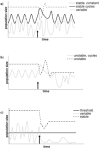Modeling and biological control of mosquitoes
- PMID: 17853610
- PMCID: PMC2771413
- DOI: 10.2987/8756-971X(2007)23[252:MABCOM]2.0.CO;2
Modeling and biological control of mosquitoes
Abstract
Models can be useful at many different levels when considering complex issues such as biological control of mosquitoes. At an early stage, exploratory models are valuable in exploring the characteristics of an ideal biological control agent and for guidance in data collection. When more data are available, models can be used to explore alternative control strategies and the likelihood of success. There are few modeling studies that explicitly consider biological control in mosquitoes; however, there have been many theoretical studies of biological control in other insect systems and of mosquitoes and mosquito-borne diseases in general. Examples are used here to illustrate important aspects of designing, using and interpreting models. The stability properties of a model are valuable in assessing the potential of a biological control agent, but may not be relevant to a mosquito population with frequent environmental perturbations. The time scale and goal of proposed control strategies are important considerations when analyzing a model. The underlying biology of the mosquito host and the biological control agent must be carefully considered when deciding what to include in a model. Factors such as density dependent population growth in the host, the searching efficiency and aggregation of a natural enemy, and the resource base of both have been shown to influence the stability and dynamics of the interaction. Including existing mosquito control practices into a model is useful if biological control is proposed for locations with current insecticidal control. The development of Integrated Pest Management (IPM) strategies can be enhanced using modeling techniques, as a wide variety of options can be simulated and examined. Models can also be valuable in comparing alternate routes of disease transmission and to investigate the level of control needed to reduce transmission.
Figures

Similar articles
-
Stage-structured discrete-time models for interacting wild and sterile mosquitoes with beverton-holt survivability.Math Biosci Eng. 2019 Jan 11;16(2):572-602. doi: 10.3934/mbe.2019028. Math Biosci Eng. 2019. PMID: 30861657
-
Wolbachia incompatible insect technique program optimization over large spatial scales using a process-based model of mosquito metapopulation dynamics.BMC Biol. 2024 Nov 21;22(1):269. doi: 10.1186/s12915-024-02070-1. BMC Biol. 2024. PMID: 39574078 Free PMC article.
-
Sex-structured wild and sterile mosquito population models with different release strategies.Math Biosci Eng. 2019 Feb 20;16(3):1313-1333. doi: 10.3934/mbe.2019064. Math Biosci Eng. 2019. PMID: 30947422
-
Sexual chemoecology of mosquitoes (Diptera, Culicidae): Current knowledge and implications for vector control programs.Parasitol Int. 2017 Apr;66(2):190-195. doi: 10.1016/j.parint.2016.09.010. Epub 2016 Sep 28. Parasitol Int. 2017. PMID: 27692501 Review.
-
Aquatic insect predators and mosquito control.Trop Biomed. 2009 Dec;26(3):223-61. Trop Biomed. 2009. PMID: 20237438 Review.
Cited by
-
Optimizing the releasing strategy used for the biological control of the sugarcane borer Diatraea saccharalis by Trichogramma galloi with computer modeling and simulation.Sci Rep. 2024 Apr 25;14(1):9535. doi: 10.1038/s41598-024-60146-y. Sci Rep. 2024. PMID: 38664543 Free PMC article.
-
Complementarity of empirical and process-based approaches to modelling mosquito population dynamics with Aedes albopictus as an example-Application to the development of an operational mapping tool of vector populations.PLoS One. 2020 Jan 17;15(1):e0227407. doi: 10.1371/journal.pone.0227407. eCollection 2020. PLoS One. 2020. PMID: 31951601 Free PMC article.
-
Modeling transmission dynamics and control of vector-borne neglected tropical diseases.PLoS Negl Trop Dis. 2010 Oct 26;4(10):e761. doi: 10.1371/journal.pntd.0000761. PLoS Negl Trop Dis. 2010. PMID: 21049062 Free PMC article. Review.
-
An age-structured extension to the vectorial capacity model.PLoS One. 2012;7(6):e39479. doi: 10.1371/journal.pone.0039479. Epub 2012 Jun 19. PLoS One. 2012. PMID: 22724022 Free PMC article.
-
Can Horton hear the whos? The importance of scale in mosquito-borne disease.J Med Entomol. 2014 Mar;51(2):297-313. doi: 10.1603/me11168. J Med Entomol. 2014. PMID: 24724278 Free PMC article.
References
-
- Anderson RM, May RM. Infectious diseases of humans: dynamics and control. Oxford University Press; Oxford: 1991. p. 757.
-
- Basáñez MG, Ricárdez-Esquinca J. Models for the population biology and control of human onchocerciasis. Trends Parasitol. 2001;17:430–438. - PubMed
-
- Begon M, Bowers RG, Kadianakis N, Hodgkinson DE. Disease and community structure: the importance of host self-regulation in a host-host-pathogen model. Am Nat. 1992;139:1131–1150.
-
- Beugnet F, Chalvet-Monfray K, Sabatier P. Use of a mathematical model to study the control measures of the cattle tick Boophilus microplus population in New Caledonia. Vet Parasitol. 1998;77:277–288. - PubMed
-
- Birley MH, Walsh JF, Davies JB. Development of a model for Simulium damnosum s.l. recolonization dynamics at a breeding site in the Onchocerciasis Control Programme Area when control is interrupted. J Appl Ecol. 1983;20:507–519.
Publication types
MeSH terms
Grants and funding
LinkOut - more resources
Full Text Sources
Medical

